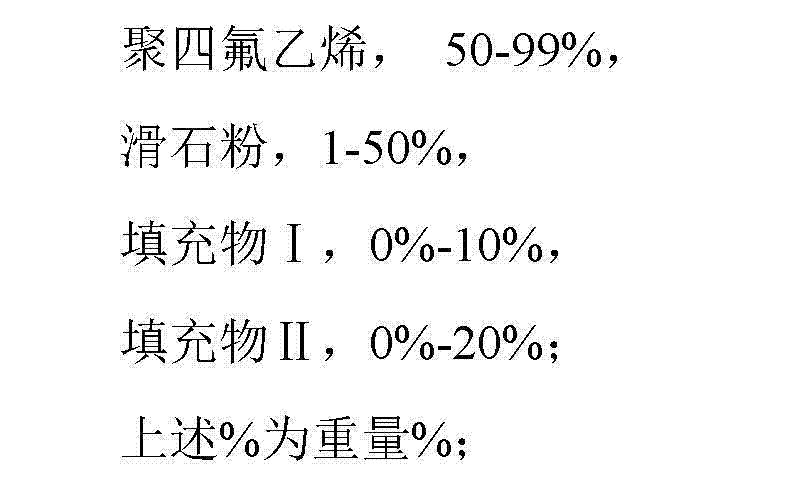Preparation method of talc filled PTFE composite material
A composite material and talc technology, applied in the field of polytetrafluoroethylene composite material and its preparation, can solve the problems of complex preparation process, large surface wear of abrasive parts, high hardness of ceramic powder, etc., and achieve simple preparation process and strong market competitiveness. , the effect of large filling ratio
- Summary
- Abstract
- Description
- Claims
- Application Information
AI Technical Summary
Problems solved by technology
Method used
Image
Examples
Embodiment 1
[0042] Example 1. A method for preparing a talc-filled PTFE composite material, followed by the following steps:
[0043] 1) Ingredients:
[0044] PTFE (particle size 50 μm), 90%,
[0045] Talc (particle size 5 μm), 10%.
[0046] 2) Put the mixture prepared in step 1) into a mixer and stir evenly at high speed; then cold-press molding (ie, press molding at room temperature) under a pressure of 38 MPa, and the cold-pressing time is 3 minutes.
[0047] 3) Put the molded product obtained in step 2) into a high-temperature sintering furnace, and heat it at a temperature increase rate of 80°C / hour. When the temperature reaches 290°C, keep it for 30 minutes; then continue to heat it to a temperature of 60°C / hour Keep at 370°C for 0.5 hour.
[0048] 4) The sintered product obtained in step 3) is cooled to 290°C at a rate of 60°C / hour and kept for 24 minutes, and then naturally cooled to room temperature to obtain a talc-filled PTFE composite material.
[0049] The talc-filled PTFE composite mat...
Embodiment 2
[0050] Example 2. A method for preparing a talc-filled PTFE composite material, followed by the following steps:
[0051] 1) Ingredients:
[0052] PTFE (particle size 50 μm), 80%,
[0053] Talc (particle size 5 μm), 20%.
[0054] 2) Put the mixture prepared in step 1) into a mixer and stir evenly at high speed; then cold-press molding (ie, press molding at room temperature) under a pressure of 38 MPa, and the cold-pressing time is 3 minutes.
[0055] 3) Put the molded product obtained in step 2) into a high-temperature sintering furnace and heat it at a heating rate of 60°C / hour. When the temperature reaches 290°C, keep it for 30 minutes; then continue to heat it at a heating rate of 30°C / hour to Keep the temperature at 370°C for 1 hour.
[0056] 4). The sintered product obtained in step 3) is cooled to 290°C at a rate of 60°C / hour, kept for 24 minutes, and then naturally cooled to room temperature to obtain a talc-filled PTFE composite material.
[0057] The talc-filled PTFE composite m...
Embodiment 3
[0058] Example 3. A method for preparing a talc-filled PTFE composite material, followed by the following steps:
[0059] 1) Ingredients:
[0060] PTFE (particle size 50 μm), 87%,
[0061] Talc (particle size 10 μm), 10%,
[0062] Nano Al 2 O 3 (60 nm), 3%.
[0063] 2) Put the mixture prepared in step 1) into a mixer and stir evenly at high speed; then cold-press molding (ie, press molding at room temperature) under a pressure of 35 MPa, and the cold-pressing time is 5 minutes.
[0064] 3) Put the molded product obtained in step 2) into a high-temperature sintering furnace and heat it at a heating rate of 60°C / hour. When the temperature reaches 290°C, keep it for 30 minutes; then continue to heat it at a heating rate of 30°C / hour to Keep the temperature at 370°C for 1 hour.
[0065] 4). The sintered product obtained in step 3) was cooled to 292°C at a rate of 60°C / hour and kept for 30 minutes, and then naturally cooled to room temperature to obtain a talc-filled PTFE composite material....
PUM
| Property | Measurement | Unit |
|---|---|---|
| Granularity | aaaaa | aaaaa |
| Diameter | aaaaa | aaaaa |
| Granularity | aaaaa | aaaaa |
Abstract
Description
Claims
Application Information
 Login to View More
Login to View More - R&D
- Intellectual Property
- Life Sciences
- Materials
- Tech Scout
- Unparalleled Data Quality
- Higher Quality Content
- 60% Fewer Hallucinations
Browse by: Latest US Patents, China's latest patents, Technical Efficacy Thesaurus, Application Domain, Technology Topic, Popular Technical Reports.
© 2025 PatSnap. All rights reserved.Legal|Privacy policy|Modern Slavery Act Transparency Statement|Sitemap|About US| Contact US: help@patsnap.com

